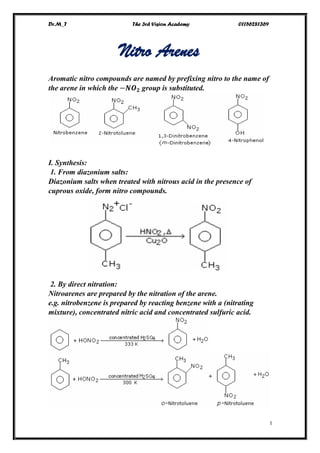The document discusses nitroarenes, focusing on their names, synthesis methods, and reactivity patterns in electrophilic and nucleophilic reactions. It elaborates on how the nitro group acts as an electron-withdrawing group, affecting the reactivity of the aromatic ring and influencing substitution patterns. Additionally, it covers reduction processes of nitro compounds and their applications, particularly in explosives like TNT and picric acid.





![Dr.M_T The 3rd Vision Academy 01156281369
VI
*Mechanism;
Aromatic nucleophilic substitution (Meisenheimer Mechanism)
𝑺 𝒏 𝑨𝒓 mechanism [addition/elimination]:
This is the most important of the mechanisms for nucleophilic aromatic
substitution reactions.
Step 1:
Addition step:
The reaction begins with attack by the nucleophile on the ring carbon
bearing the leaving group.
This produces an anionic intermediate. This ion, known as the
Meisenheimer complex, is resonance stabilized.
Step 2:
Elimination step:
The ring undergoes "re-aromatization" with the loss of the Leaving
Group.
The first step, in which the ring loses it aromatic stabilization and the
anion is produced is the slow or Rate Determining Step (RDS).
However, the reaction as shown above would not proceed to yield
product!
Resonance stabilization alone is not sufficient for the anionic](https://image.slidesharecdn.com/ar-nitro-170104122614/85/Ar-nitro-6-320.jpg)




![Dr.M_T The 3rd Vision Academy 01156281369
XI
5. Selective Reduction of Nitro group
In the presence of other reducible groups like - CH = CH2 or - CHO etc.
on the ring, the nitro group may be selectively reduced to amino group
using alkaline FeSO4.
*Note;
When two nitro groups are present at m-position, one of them may be
selectively reduced to nitro group using ammonium hydrogen sulphide
[(NH4)2S] or sodium polysulphide [Na2Sx] as the reducing agent.](https://image.slidesharecdn.com/ar-nitro-170104122614/85/Ar-nitro-11-320.jpg)



